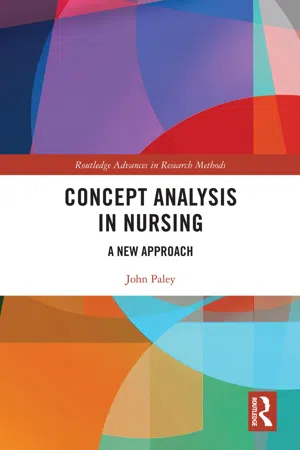
- 312 pages
- English
- ePUB (mobile friendly)
- Available on iOS & Android
About This Book
Concept analysis is an established genre of inquiry in nursing, introduced in the 1970s. Currently, over 100 concept studies are published annually, yet the methods used within this field have rarely been questioned. In Concept Analysis in Nursing: A New Approach, Paley provides a critical analysis of the philosophical assumptions that underpin nursing's concept analysis methods. He argues, provocatively, that there are no such things as concepts, as traditionally conceived.
Drawing on Wittgenstein and Construction Grammar, the book first makes a case for dispensing with the traditional concept of a 'concept', and then provides two examples of a new approach, examining the use of 'hope' and 'moral distress'. Casting doubt on the assumption that 'hope' always stands for an 'inner' state of the person, the book shows that the word's function varies with the grammatical construction it appears in. Similarly, it argues that 'moral distress' is not the name of a mental state, but a normative classification used to bolster a narrative concerning nursing's identity.
Concept Analysis in Nursing is a fresh and challenging book written by a philosopher interested in nursing. It will appeal to researchers and postgraduate students in the areas of nursing, health, philosophy and linguistics. It will also interest those familiar with the author's previous book, Phenomenology as Qualitative Research.
Frequently asked questions
1 Aims, methods, conventions
1.1 Two aims
1.2 Two expressions
1.3 Summary of the argument in Part I
- [2] We generally think of ‘the concept of hope’ (for example) as a singular something which underlies the various uses of the word ‘hope’. ‘Hope’ expresses the same concept whenever it is used, irrespective of the grammatical construction it appears in. This is a familiar picture of the relation between words and concepts. In this chapter, I outline an alternative picture. The function of the word ‘hope’ varies with the constructions it occurs in; and the expression ‘the concept of hope’ is just a way of referring (vaguely) to the overall pattern of usage.
- [3] We assume that nouns are naming words, and the assumption is more deeply entrenched than we realise. ‘Concept’ is a noun, so it must name something. However, this chapter shows that many nouns don’t name anything at all, even if they are extremely useful; and some nouns don’t always name things, even if they sometimes do. The non-naming functions of nouns – or any other type of word – vary with the linguistic context in which they appear.
- [4] One important non-naming function of nouns is this: to refer to something without naming it, or (more often) to refer to a domain of things without naming, identifying or describing any of the items in that domain. This function is most visible in words such as ‘things’ and ‘stuff’; but other nouns also perform this function in certain linguistic contexts. These contexts include anaphoric reference and some types of metonymy. (Terms such as these are explained in the Glossary, and more fully when we get to the relevant chapters.)
- [5] The expression ‘the concept of X’ has this referring-without-naming function. It enables us to refer to a large, ill-defined, diverse domain of things – how X is understood, thought about, discussed; how the word ‘X’ is used, and with what purpose; how Xs are identified; and so on – without identifying, or needing to identify, any of those things. Concept possession is explained in a similar way, with a further observation: if someone ‘has the concept of X’, it does not follow that there is ‘something that she has’. Many idiomatic uses of the verb ‘to have’ are such that, if someone ‘has an X’, there is no ‘X’ that she possesses.
- [6] We generally assume that there must be concepts. In this chapter, I consider two ‘indispensability arguments’: there must be concepts because, if there were not: (a) we could not categorise things, could not have beliefs and could not make judgments; (b) there would be nothing to serve as the constituents of thoughts or propositions. I show why, given the preceding discussion, these arguments do not have any traction.
- [7] ‘The concept of X’ is not a singular something which explains the various uses of ‘X’. It is rather an expression which permits us to refer, in vague terms, to the pattern of usage associated with ‘X’. So ‘concept analysis’ – if it is supposed to lead to a ‘definition’, or a list of the concept’s structure and attributes – is a non-starter. The alternative is to explore the uses of ‘X’, bearing in mind that the same word can have many different uses, and that its function varies with the grammatical constructions in which it occurs. This approach combines Wittgenstein’s methods with something called Construction Grammar. (I introduce the latter in Section 2.4; see also the Glossary.)
1.4 The hypothetical reader
1.5 Style of argument
Table of contents
- Cover
- Half-Title
- Series
- Title
- Copyright
- Contents
- List of figures
- Preface and acknowledgements
- Glossary
- 1 Aims, methods, conventions
- PART I Concepts
- PART II Words
- Index